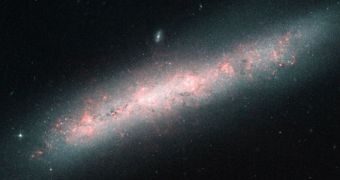Using the NASA/ESA Hubble Space Telescope, astronomers have recently been able to capture an amazing view of the barred spiral galaxy NGC 4700. One of the most amazing aspects of the galaxy is the high number of stellar nurseries it displays.
These are areas of intense stellar formation, where hydrogen gas clouds collapse into protostars. They are known as H II regions because extreme ultraviolet light from nearby, bright stars is ionizing the clouds, making them appear in multiple colors.
NGC 4700 has roughly the same structure as our own galaxy, the Milky Way. It is currently located some 50 million light-years away, in the constellation of Virgo, but it's moving away at a speed of around 1,400 kilometers/second, under the action of cosmic expansion.
French astronomer Nicolas-Claude Fabri de Peiresc was the first to detect a H-II region, the now-famous Orion Nebula, back in 1610. Since then, more modern telescopes have made detecting such stellar nurseries easier.

 14 DAY TRIAL //
14 DAY TRIAL //